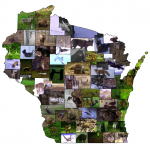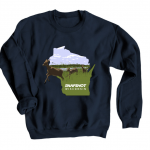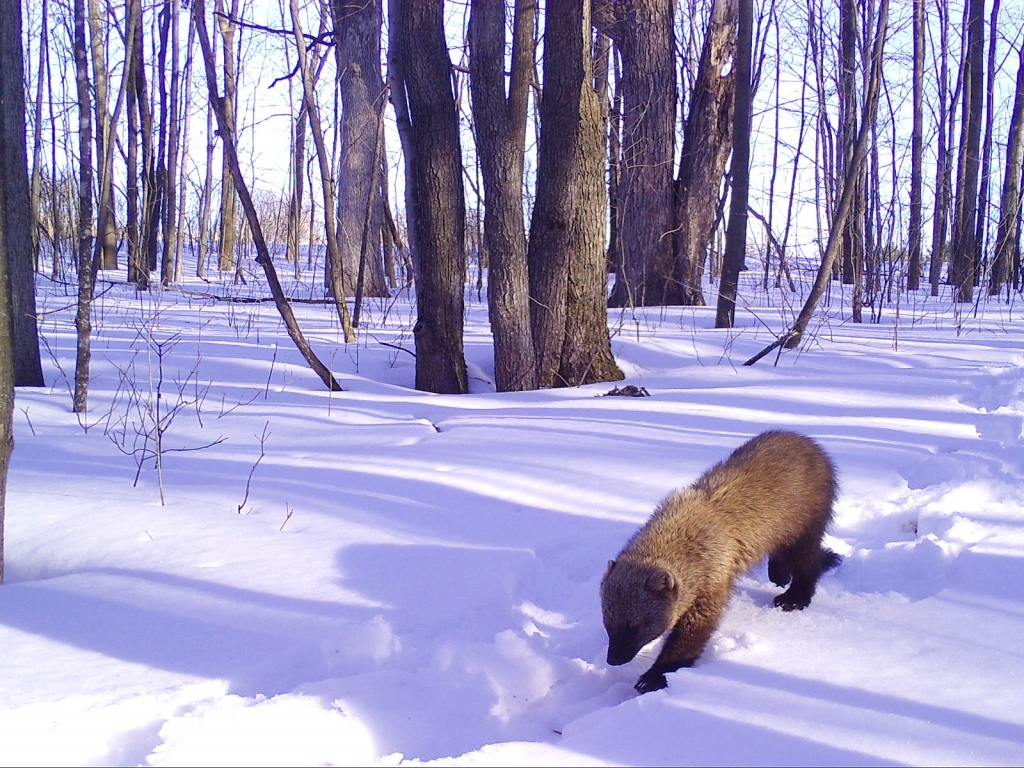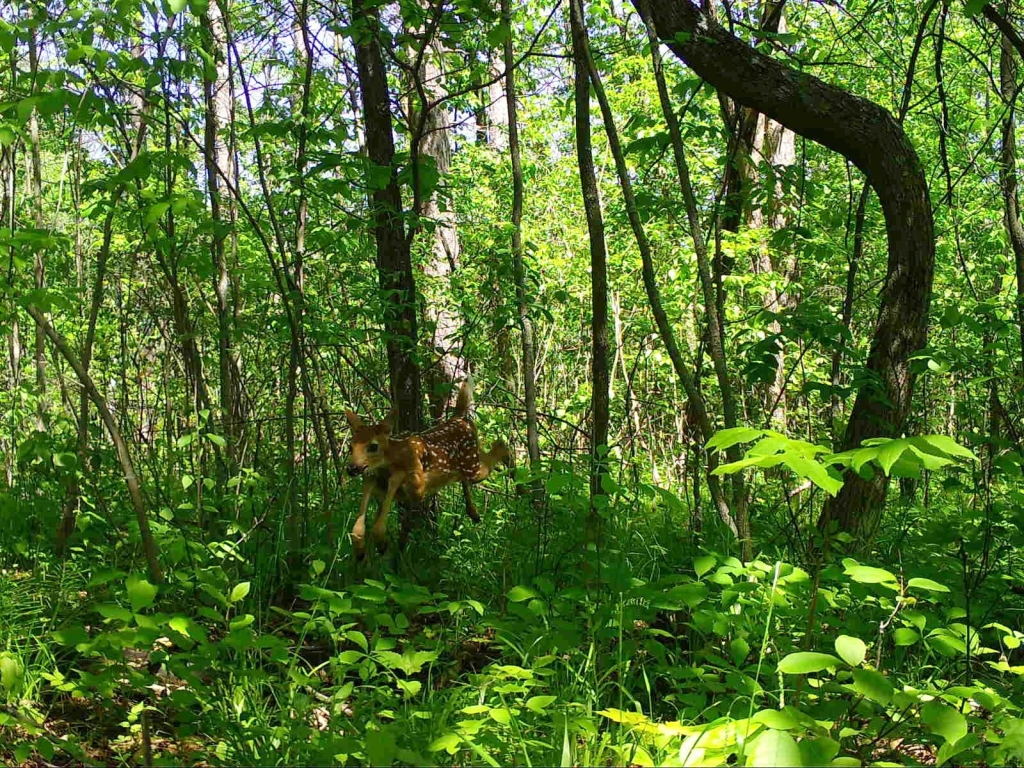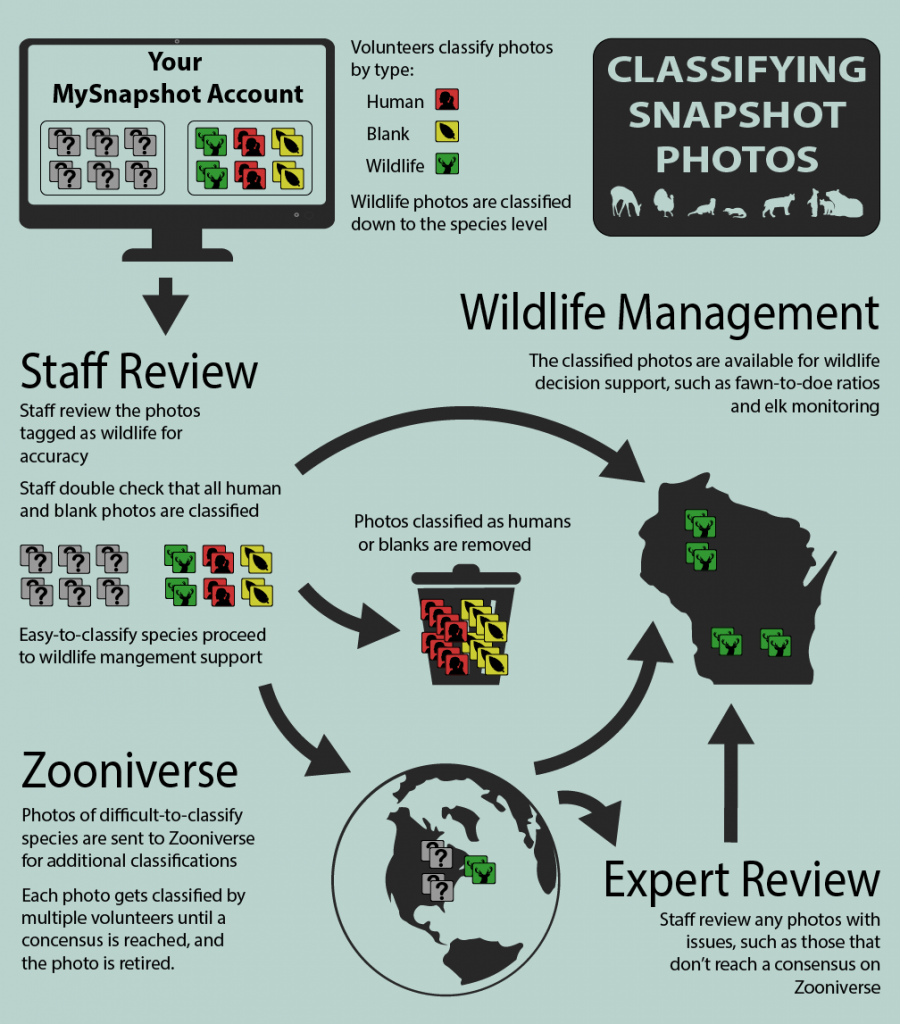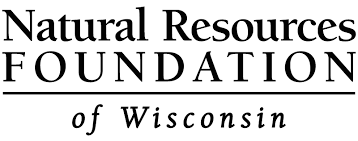Snapshot Wisconsin December 2020
This edition of the Snapshot newsletter centers around an important milestone for Snapshot Wisconsin, reaching 50 million photos! The Snapshot team also addresses a question many of our volunteers have thought about at some point - How do we process all these photos?
Volunteers may be especially interested in a new partnership between Snapshot Wisconsin and the Natural Resources Foundation of Wisconsin. This partnership will expand Snapshot’s reach and offer new opportunities for volunteers and friends! Read all about it.
The Snapshot Team’s Favorite Photos from the First 50 Million
To celebrate Snapshot Wisconsin reaching its 50 millionth photo, the Snapshot team built an interactive map with some of the team’s favorite photos from around the state. It also highlights many of the exciting moments we’ve caught on camera over the years.
What Happens to Photos Once Uploaded?
The Snapshot team addresses one of the most commonly-asked questions: what happens to photos once uploaded? Jamie Bugel, Snapshot team member, walks us through the process and discusses key steps that are important to ensuring Snapshot’s data is high quality.
Partnering with the Natural Resources Foundation of Wisconsin and a New Snapshot Store!
Snapshot Wisconsin has partnered with the Natural Resources Foundation of Wisconsin to expand both groups’ reach and offer new opportunities to our volunteers, including a Snapshot merchandise store!
The Snapshot Team’s Favorite Photos from the First 50 Million!
Snapshot Wisconsin recently reached an important milestone: its 50 millionth photo! We’ve been watching the tally of photos get closer and closer to 50 million for the last few months, and we are thrilled that the moment is finally here.
Snapshot Wisconsin started as a pilot program in only two counties in 2016 but expanded statewide in 2018. Today, we have over 1,800 volunteers, monitoring over 2,100 trail cameras across the state. Furthermore, the Snapshot program receives approximately 45,000 photos per day from all these cameras. Just stop and think about how incredible that is!
As a thank you to everyone who has helped the program out or followed its success (and to celebrate the 50 millionth photo milestone), the Snapshot Wisconsin team selected some of their favorite photos from the first 50 million and used them to build an interactive map of Wisconsin. This tool highlights each photo and tells a short story about the photo itself or the species shown. It serves as a “snapshot” of how the program has grown over the years.
Rare species sightings, unusual animal behaviors, species facts, and even a few multi-species encounters can all be seen in the interactive map. Check it out!
What Happens to Photos Once Uploaded?
Since Snapshot reached 50 million photos, the Snapshot team felt it was a good time to address one of the most asked questions about photos: what happens to photos once they are uploaded by volunteers? At first, the process seems complicated, but member of the Snapshot team, Jamie Bugel, is here to walk us through the process, one step at a time.
Bugel is a Natural Resources Educator and Research Technician at the DNR, but she works on the volunteer side of Snapshot. Bugel said, “I mainly help volunteers troubleshoot issues with their equipment or with their interactions with the MySnapshot interface. I am one of the people who answer the Snapshot phone, and I help update the user interface by testing functionality. There is also lots of data management coordination on the volunteer side of the program that I help with.”
Bugel listed off a few of the more common questions she and the rest of the Snapshot team get asked, including who reviews photos after the initial classification, what happens to the photos that camera hosts can’t identify and how do mistakes get rectified. “We get asked those [questions] on a weekly to daily basis,” said Bugel.
It Starts with a Three-Month Check and an Upload
Every three months, trail camera hosts are supposed to swap out the SD card and batteries in their trail camera. At the same time, volunteers fill out a camera check sheet, including what time of day they checked the camera, how many photos were on the SD card and if there was any equipment damage.
“You should wait at least three months to check their camera, because you won’t disturb the wildlife by checking more often. We want to view the wildlife with as minimal human interference as possible,” said Bugel. “At the same time, volunteers should check [their camera] at least every three months, because batteries don’t last much longer than three months. Checking this often is important to avoid missing photos.”
After the volunteer does their three-month check, they bring their camera’s SD card back to their home and enter the information on their camera check sheet into their MySnapshot account and upload their photos.
Bugel said it can take anywhere from 4 to 48 hours for the photos to appear in the volunteer’s MySnapshot account. Fortunately, the server will send an email when the photos are ready, so volunteers don’t have to keep checking. Volunteers can start classifying their photos after receiving the email.
Initial Classification by Camera Hosts
The first round of classification is done by the trail camera hosts. The returned photos will sit in the Review Photos section of their MySnapshot account while the host classifies the photos as Human, Blank or Wildlife. The wildlife photos are also further classified by which species are present in the photo, such as beaver, deer or coyote.
This initial classification step is very important for protecting the privacy of our camera hosts, as well as helps on the back end of data processing. Over 90% of all photos are classified at this step by the camera hosts. When they are done classifying photos, they click “review complete,” and the set of photos is sent to the Snapshot team for the second round of classification.
Staff Review
The second round of classification is the staff review. Members of the Snapshot team review sets of photos to verify that all human or blank photos have been properly flagged. “For example, a deer photo may include a deer stand in the background. That type of photo will not go to Zooniverse because there is a human object in the photo,” said Bugel. Fortunately, nearly all human photos are taken during the initial camera setup or while swapping batteries and SD card, so they are usually clumped and easy to spot.
The second reason that staff review photos after the initial classification is for quality assurance. Since some animal species are tricky to correctly classify, someone from the Snapshot team reviews sets to verify that the photos were tagged with the correct species. This quality assurance step helps rectify mistakes. “Sometimes there are photos classified as blank or a fawn that are actually of an adult deer,” said Bugel. “We want to catch that mistake before it goes into our final database.”
In cases where the set of photos wasn’t classified by the camera host, the team will also perform the initial classification to remove human and blank photos. The Snapshot team wants to make sure any photos that reveal the volunteer’s identity or the location of the camera are removed before those photos continue down the pipeline.
Branching Paths
At this point in the process, photos branch off and go to different locations, depending on what classification they have. Blank (43%) and human (2%) photos are removed from the pipeline at this point. Meanwhile, the wildlife photos (20%) move on to either Zooniverse for consensus classification or move directly to the final dataset. The remaining photos don’t fall into one of our categories, such as the unclassified photos still awaiting initial review.
Photos of difficult-to-classify species, such as wolves and coyotes, are sent to Zooniverse for consensus classification. Bugel explained, “The photos [of challenging species] will always go to Zooniverse, even after volunteer classification and staff member verification, because we’ve learned we need more eyes on those to get the most accurate classification possible,” another layer of quality assurance.
Alternatively, photos with easy-to-classify species, such as deer or squirrel, go directly to the final dataset. Bugel said, “If a photo is classified as a deer or fawn, we trust that the volunteer correctly identified the species.” These photos do not go to Zooniverse.
Zooniverse
Photos of difficult-to-classify species or unclassified photos move on to Zooniverse, the crowdsourcing platform, for consensus classification. “Wolf and coyote photos, for example, always go to Zooniverse, because it is so hard to tell the difference, especially in blurry or nighttime photos,” said Bugel.
The Snapshot team has run accuracy analyses for most Wisconsin species to determine which species’ photos need consensus classification. All photos of species with low accuracies go to Zooniverse.
On Zooniverse, volunteers from around the globe classify the wildlife in these photos until a consensus is reached, a process called consensus classification. Individual photos may be classified by up to eleven different volunteers before it is retired, but it could be as few as five if a uniform consensus is reached early. “It all depends on how quickly people agree,” said Bugel.
Team members upload photos to Zooniverse in sets of ten to twenty thousand, and each set is called a season. Bugel explained, “Once all of the photos in that season are retired, we take a few days break to download all of the classifications and add them to our final dataset. Then, a Snapshot team member uploads another set of photos to Zooniverse.” Each set takes roughly two to four weeks to get fully classified on Zooniverse.
To date, over 10,400 people have registered to classify photos on Zooniverse, and around 10% of the total photos have been classified by these volunteers on Zooniverse.
Expert Review
It is also possible for no consensus to be reached, even after eleven classifications. This means that no species received five or more votes out of the eleven possible classifications. These photos are set aside for later expert review.
Expert review was recently implemented by the Snapshot team and is the last step before difficult photos go into the final dataset. The team has to make sure all photos have a concrete classification before they can go into the final dataset, yet some photos never reached a consensus. Team members review these photos again, while looking at the records of how each photo was classified during initial review and on Zooniverse. While there will always be photos that are unidentifiable, expert review by staff helps ensure that every photo is as classified as possible, even the hard ones.
The Final Dataset and Informing Wildlife Management
Our final dataset is the last stop for all photos. This dataset is used by DNR staff to inform wildlife management decisions around the state.
Bugel said, “The biggest management decision support that Snapshot provides right now is fawn-to-doe ratios. Jen [Stenglein] uses Snapshot photo data, along with data from other initiatives, to calculate a ratio of fawns to does each year and that ratio feeds into the deer population model for the state.”
Snapshot has also spotted rare species too, such as a marten in Vilas county and a whooping crane in Jackson county. Snapshot cameras even caught sight of a cougar in Waupaca county, one of only a handful of confirmed sightings in the state.
The final dataset feeds into other Snapshot Wisconsin products, including the Data Dashboard, and helps inform management decisions for certain species like elk. Now that the final dataset has reached a sufficient size, the Snapshot team is expanding its impact by feeding into other decision-making processes at the DNR and developing new products.
The Snapshot team hopes that this explanation helps clarify some of the questions our volunteers have about what happens to their photos. We know the process can seem complicated at first, and the Snapshot team is happy to answer additional questions about the process. Reach out to them through their email or give them a call at +1 (608) 572 6103.
Partnering with the Natural Resources Foundation of Wisconsin and a New Snapshot Store!
Some of our volunteers may already know that Snapshot Wisconsin recently partnered with the Natural Resources Foundation of Wisconsin (NRF), but we at Snapshot haven’t shared many of the details about this partnership yet, including new opportunities available to volunteers and a Snapshot merchandise store!
Christine Anhalt-Depies, Project Coordinator for Snapshot Wisconsin, virtually sat down with Cait Williamson, Director of Conservation Programs within the NRF, to chat about what this partnership means to their programs, as well as highlight how their volunteers benefit from this partnership.
What is the Natural Resources Foundation of Wisconsin?
The NRF is a non-profit foundation that is all about funding conservation work. The NRF has a long history of supporting the DNR’s priority projects, especially those that involve species with the greatest conservation need. The NRF also connects people to conservation opportunities throughout the state through their Field Trip program, the Great Wisconsin Birdathon and many other funded programs.
The NRF was established in 1986 after significant cuts to the DNR budget. The DNR leadership at the time recognized a need to have an independent foundation to bridge private sector support for natural resources and conservation work being done, so the NRF grew to fill that need.
Williamson added, “We support over 200 different projects each year from small-scale school projects to large-scale conservation projects, even [projects] at the federal level. Our niche is conservation funding, leveraging resources from corporations, foundations and individuals. Putting those financial resources to the highest priority conservation needs for Wisconsin.”
Snapshot Wisconsin fits well into the types of projects that the NRF funds, so this partnership was a natural fit. Plus, forming this partnership had a special twist in store for Anhalt-Depies and Williamson.
Forming This Partnership
Anhalt-Depies and Williamson first sat down over coffee over a year ago to discuss forming this partnership. However, the meeting was more than just a brainstorming session about what the partnership would look like. It was a reunion for Anhalt-Depies and Williamson.
The pair first met while Anhalt-Depies was working on her project for her master’s degree nearly a decade ago. Part of the project involved radio-collaring wolves, so Anhalt-Depies collaborated with the DNR. Meanwhile, Williamson was an intern with the DNR, assigned to work with the wolf program. Anhalt-Depies and Williamson worked together very closely for months until the field work was done, then they went their separate ways.
Anhalt-Depies later went on to work with Snapshot Wisconsin and eventually became the project coordinator. On the other hand, Williamson started working at the NRF and became the one who builds partnerships with the DNR (and other conservation or education groups), as well as determines what the NRF’s priorities are. Williamson said, “I have the fun job of giving away the funds we help raise and knowing those are going to have the most impact they can.”
Anhalt-Depies explained what motivated her to reach out to Williamson again. “As Snapshot grew to a state-wide program, we identified the need to partner with groups that could help us expand our reach, especially in the area of supporting education. NRF seems like a natural fit, based on their goals and mission. I reached out to [Williamson]. We sat down and had a great brainstorming session about what a partnership between the two would look like and how we could help each other reach our goals.”
Williamson added, “It was fun to reconnect with [Anhalt-Depies]. We [at the NRF] have heard about and been informally in-the-loop on Snapshot Wisconsin, so it seemed like a natural fit because of what Snapshot is - engaging people and providing critical data. It was a no brainer for us.”
“It’s awesome to be able to offer yet another opportunity for our members and our partners to engage with Wisconsin’s natural resources,” said Williamson, and engage, they can. Not only do Snapshot volunteers benefit, but so do the NRF’s members.
How do Snapshot Volunteers and NRF’s Members Benefit?
Anhalt-Depies shared how this partnership benefits Snapshot volunteers. “This partnership helps expand our reach,” said Anhalt-Depies. “It brings the Snapshot program to a new audience, helping us to continue to grow.”
Anhalt-Depies continued, “The fundraising support NRF brings to the partnership will also help to increase our educational impact. Roughly 15% of Snapshot volunteers are educators. This partnership will expand the resources available to these educators, helping them to better integrate conservation education into their classroom.”
At the same time, the NRF and its members benefit from connecting to Snapshot Wisconsin. Williamson said, “From a conservation side, we [the NRF] are all about supporting priority needs for our state. Science-based conservation and the data that informs it is super critical, so we are happy to be able to support Snapshot and growing the program.”
“For our members, Snapshot Wisconsin is a really good way to connect them with something they can do,” continued Williamson. “Whether they are hosting cameras or classifying images on Zooniverse, it gives them one more way that they can give back to Wisconsin’s natural resources.”
A Message from our NRF Partners
Another important way that the NRF is helping Snapshot Wisconsin is through providing funding opportunities, either through donations or merchandise sales. Our partners shared with us a special message for Snapshot volunteers, announcing these new ways to help out the Snapshot program.
At the Natural Resources Foundation of Wisconsin, we believe that nature has inherent value and that people have the ability to make a difference. We are the bridge connecting people who want to help with meaningful opportunities to make a lasting impact on Wisconsin’s lands, waters, wildlife and future stewards. We are very excited about our new partnership with Snapshot Wisconsin, which will connect our NRF members with meaningful volunteer opportunities, directly fund efforts that inform conservation decisions and help us learn more about Wisconsin’s amazing wildlife.
Want to show off your love for Snapshot Wisconsin and help support this incredible program? Check out our Snapshot Wisconsin storefront, featuring t-shirts, sweatshirts, hats and mugs – every purchase directly supports Snapshot! You can also donate directly by visiting
WisConservation.org/donate and designating your gift to Snapshot Wisconsin.
Between connecting our volunteers to the resources of the NRF network and new funding to expand what Snapshot is able to do, the Snapshot team is excited for this partnership. There is so much synergy between Snapshot’s goals and NRF’s mission that this partnership is a natural fit.
The partnership has also brought back together Anhalt-Depies and Williamson, and each shared some parting words for readers.
Williamson said, “Five years back, we had a visioning session about what we were really accomplishing for conservation in the state. We are not the boots on the ground ourselves, but what we do is connect people to that. There are so many ways people can make a difference. Whether it is through philanthropy, volunteering their time or just the personal choices they make to support our state’s natural resources… We are all about how people can make a difference, and Snapshot is one of those ways.”
Anhalt-Depies added, “Snapshot is people-powered research. We have thousands of volunteers who are donating their time and making a huge impact on the number of photos collected and total information gathered on our state’s natural resources. This partnership with the NRF helps to make their efforts go just a bit further, and at the end of the day, that is what matters.”

